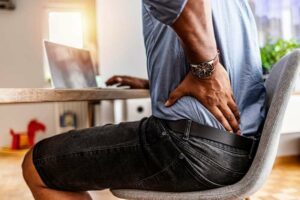Experiencing pain, particularly in the lower left part of your back, can be unsettling. It can interrupt your daily activities and leave you searching for relief. Stabbing pain in the lower left back pain could arise from various issues ranging from minor muscle strain to more severe conditions such as kidney stones or spinal problems. This article aims to shed light on the possible causes of this kind of pain, available treatment options, and preventive measures.
Contents
What Is Stabbing Pain In Lower Left Back?
 Stabbing pain in the lower left back is characterized by a sharp, intense sensation of discomfort that originates in the lower part of the back, more specifically on the left side. This type of pain can occur suddenly or develop gradually over time. And it may fluctuate in intensity. The sensation is often likened to being pricked by a needle or stabbed with a knife, hence the term ‘stabbing’.
Stabbing pain in the lower left back is characterized by a sharp, intense sensation of discomfort that originates in the lower part of the back, more specifically on the left side. This type of pain can occur suddenly or develop gradually over time. And it may fluctuate in intensity. The sensation is often likened to being pricked by a needle or stabbed with a knife, hence the term ‘stabbing’.
The lower back is a complex structure composed of numerous interconnected elements including bones, muscles, ligaments, nerves, and other tissues. When any one of these elements becomes strained or injured, it can result in acute or chronic pain. It’s important to understand that back pain, especially when it’s severe or persistent, should not be ignored. Because it can signal more serious health problems.
When Should I Worry About Left Side Lower Back Pain?
While stabbing pain in the lower left back pain can often be attributed to a minor strain or sprain, there are times when it could indicate a more serious underlying condition that requires medical attention. Here are some scenarios in which you should definitely reach out to a healthcare professional:
- Persistent Pain: If your back pain doesn’t improve or completely resolve after a few days to a week of rest and home care (like applying heat or cold, over-the-counter pain relievers), you should consult with a healthcare professional.
- Severe Pain: If the pain is intense and doesn’t lessen with rest or lying down, it’s a good idea to seek medical attention.
- Pain Accompanied by Other Symptoms: If your back pain is accompanied by other concerning symptoms like fever, unexplained weight loss, persistent or worsening fatigue, or changes in bowel or bladder function. Then, seek immediate medical attention.
- Pain Following Injury or Trauma: If the pain started following an injury, fall, or accident, it’s important to get medical help. It will help to rule out fractures or other serious injuries.
- Neurological Symptoms: If you are experiencing numbness, tingling, weakness in the legs, or issues with walking and balance. Then, it may be a sign of nerve compression or damage.
- Pain that Disturbs Sleep: If your back pain is so severe it wakes you up at night or prevents you from getting a good night’s sleep. Then, you should consult with a healthcare provider.
In any of these scenarios, it’s crucial to reach out to a healthcare professional who can conduct a thorough examination, determine the cause of your pain, and recommend an appropriate course of treatment. It’s always better to err on the side of caution when it comes to your health.
What Causes Stabbing Pain In Lower Left Back?
 Stabbing pain in the lower left back can have various origins. Each with its own set of symptoms and potential treatments. The lower back is a complex structure of bones, muscles, nerves, and other tissues that work together to support your body. When any one of these elements becomes strained, injured, or inflamed, it can result in intense stabbing pain. Here are some common causes:
Stabbing pain in the lower left back can have various origins. Each with its own set of symptoms and potential treatments. The lower back is a complex structure of bones, muscles, nerves, and other tissues that work together to support your body. When any one of these elements becomes strained, injured, or inflamed, it can result in intense stabbing pain. Here are some common causes:
- Muscle Strain or Sprain
This is one of the most common causes of lower back pain. Overuse, heavy lifting, or a sudden, awkward movement can strain or sprain the muscles or ligaments in your back, causing sharp pain.
- Herniated Disc
The spinal discs act as cushions between the bones of your spine. When a disc becomes herniated, it means that its soft, gel-like interior has pushed through a tear in its tougher exterior. This can press on nearby nerves, leading to severe stabbing pain.
If the sciatic nerve, which runs from your lower back down each leg, becomes compressed or irritated. Then, it can result in a sharp, shooting pain in your lower back, which can extend down your leg.
- Kidney Problems
Issues such as kidney stones or infections can often cause pain in the lower back, usually on one side. If the problem is with your left kidney, you might experience stabbing pain on your lower left side.
- Spinal Stenosis
This condition is characterized by a narrowing of the spinal canal. It can put pressure on the nerves that travel through the spine. Ultimately, leading to sharp, stabbing pain.
- Arthritis
Inflammatory conditions like arthritis can affect the joints in the lower back, leading to pain and discomfort.
- Spondylolisthesis
This condition occurs when one of the lower vertebrae slips forward onto the bone directly beneath it. This can cause lower back pain and stiffness. Especially after exercise or long periods of standing or walking.
If you’re experiencing stabbing lower left back pain, it’s important to see a healthcare professional for a thorough evaluation to determine the exact cause and appropriate treatment.
How Do You Get Rid Of Back Stabbing Pain?
Treating stabbing pain in the lower back often depends on its underlying cause. That should be determined by a healthcare professional. Once the cause is identified, there are several approaches to managing and relieving the pain:
Rest
If your lower back pain is the result of a minor muscle or ligament strain, rest is often the best course of action, at least initially. This doesn’t mean you have to stay completely bedridden. But you should avoid activities that put excess strain on your back or that may exacerbate the pain. These activities might include heavy lifting, bending or twisting your back, or any movements that specifically trigger your pain. However, too much rest can lead to muscle weakness and stiffness, potentially prolonging recovery. It’s recommended to resume gentle physical activities as soon as possible.
Over-the-counter pain relievers
Over-the-counter (OTC) pain relievers are a common first line of treatment for many types of back pain. Non-steroidal anti-inflammatory drugs (NSAIDs) like ibuprofen (Advil, Motrin) not only relieve pain but also reduce inflammation, which is often a contributing factor to back pain. Acetaminophen (Tylenol), another commonly used OTC medication, can also help manage pain.
Physical Therapy
Physical therapy is an integral part of back pain management. A physical therapist can evaluate your specific condition and design a personalized exercise program to help strengthen your core muscles (those that support your lower back), improve your flexibility, and promote optimal posture and body mechanics.
These exercises might include stretching routines, low-impact aerobic exercises, and targeted strengthening exercises. Consistent physical therapy can relieve current back pain. Also help prevent future episodes by promoting a healthier, stronger back.
Heat and Cold Therapy
These therapies can provide temporary relief from lower back pain. Applying a heat pack or taking a warm bath can help loosen tight muscles, stimulate blood flow, and soothe stiff joints, which can alleviate pain. Heat is typically more beneficial for the relief of chronic muscle tension or stiffness. On the other hand, a cold pack can numb the affected area and reduce inflammation. That can be particularly helpful in the first 24 to 48 hours after an injury or onset of acute pain. It’s recommended to apply heat or cold for 15-20 minutes at a time, with a towel or cloth between your skin and the pack to avoid burns or frostbite.
Prescription Medications
When over-the-counter pain relievers are not effective, your healthcare provider may prescribe stronger medications. This might include prescription-strength NSAIDs, muscle relaxants, or even opioids for short-term relief of severe pain. Another option can be corticosteroid injections, which are often used for pain related to inflammation, such as pain from a herniated disc. Corticosteroids are powerful anti-inflammatory agents and can be directly injected into the area of pain for targeted relief.
Lifestyle changes
 Long-term management of lower back pain often involves lifestyle modifications. Regular physical activity can keep your back muscles strong and flexible, reducing the likelihood of strains. Maintaining a healthy weight can help prevent excess strain on your back. If you smoke, quitting can improve your overall health and also reduce your risk for back pain, as smoking can reduce blood flow to the spine and increase the risk of degenerative spinal problems. Stress management is also crucial, as tension can make back pain worse. This might involve practices like yoga, meditation, or other relaxation techniques.
Long-term management of lower back pain often involves lifestyle modifications. Regular physical activity can keep your back muscles strong and flexible, reducing the likelihood of strains. Maintaining a healthy weight can help prevent excess strain on your back. If you smoke, quitting can improve your overall health and also reduce your risk for back pain, as smoking can reduce blood flow to the spine and increase the risk of degenerative spinal problems. Stress management is also crucial, as tension can make back pain worse. This might involve practices like yoga, meditation, or other relaxation techniques.
Surgery
Surgery is usually a last resort for treating lower back pain, typically considered when other treatments have not worked and if the pain is severe, persistent, and debilitating. The type of surgery depends on the cause of the pain. For instance, a herniated disc may require a discectomy (removal of the herniated part of the disc) or a laminectomy (removal of the part of the bone that is compressing the nerve). Spinal stenosis might be treated with decompression surgery to widen the spinal canal. Surgery comes with risks and potential complications, so the benefits and risks should be thoroughly discussed with your healthcare provider
While these are general strategies to manage and alleviate stabbing lower back pain, it’s important to consult with a healthcare professional before starting any new treatment. They can guide you toward the most appropriate and effective treatment for your specific situation.
Conclusion
In conclusion, stabbing pain in the lower left back can stem from various causes, each demanding a unique approach to treatment. From simple rest and over-the-counter pain relievers to lifestyle modifications and, in rare cases, surgery, there are numerous strategies to manage this condition. It’s critical to consult with a healthcare professional if you’re experiencing persistent or severe pain in your lower back.
Remember, while dealing with such discomfort can be challenging, understanding the underlying cause and exploring the right treatment options can pave the way toward a pain-free life. Take care of your back, listen to your body, and never hesitate to seek help when needed.
If you’re experiencing Back pain, physical therapy for back pain at PhysioMantra can help: Book an online physical therapy session.



